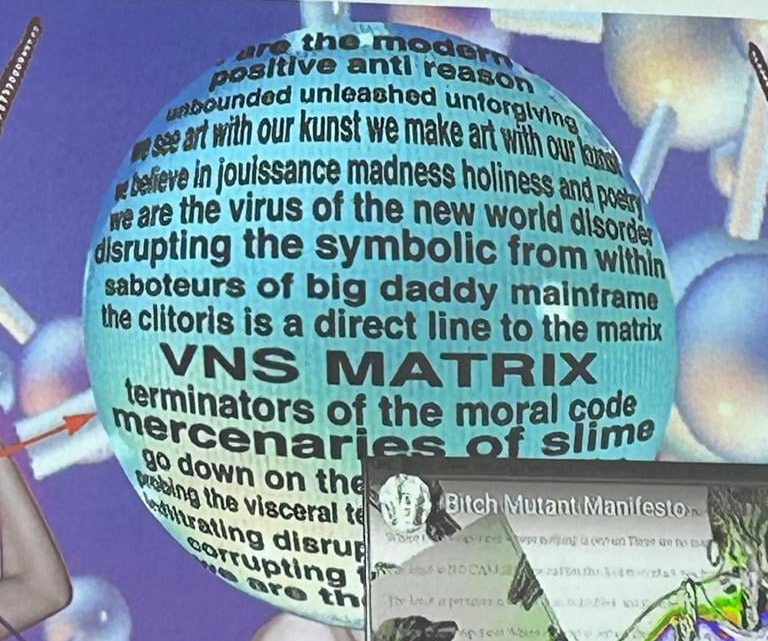
The metaphysics of lack, shared by certain theologies and certain forms of psychoanalysis, would like to convince us that we all lack something. We are told that the world is in order because women lack the penis, because men lack the uterus, because men and women lack the "transcendental phallus" - or the megadildus. We are told that animals lack the soul, and that cybernetic machines lack the flesh and the will that electrical connections come to compensate for with an excess of information ... We lack nothing. Deleuze and Guattari had already said it. We lack neither the penis nor the breasts. The body is already a territory through which multiple organs and diverse identities cross. What we lack is the desire, the rest is enough.
Paul B. Preciado. Contra sexual Manifesto
Transfeminism is a part of what is known as new feminisms. It expands the subjects considered within feminism to include others who are also oppressed by CIS heteropatriarchy, who are not necessarily cisgender women.
Transfeminism understands the concept of gender as a social construction used to oppress and exclude.
Transfeminists identify patriarchal oppression not within genders themselves, but in the inflexible binary system
'man/woman' and the fact that gender is associated to sex. Therefore, while transfeminism proposes the existence of as many genders as there are identities, gender critical feminism desires for there to be none.
Transfeminism highlights the fact that society privileges people who identify with the gender they were assigned at birth (cisgender people) and that, because it is a binary system, it only recognizes two genders (men and women), which marginalizes any other gender. However, it does not consider gender itself as good or bad. It defines it as a subjective personal and individual condition which should not be limited to masculine/feminine (there should be an infinite number of gender identities, which is why they recognize non-binary genders)
The subjects of feminism are not just cisgender women-who identify with the gender they have
-but also trans people and others who are oppressed by CIS heteropatriarchy.

The module on Critical Transfeminist Design was an eye-opening and transformative experience that deeply enriched my understanding of design and its potential for social impact. This module provided a critical lens through which to view design practices, emphasizing the importance of inclusivity, equity, and intersectionality in creating meaningful and empowering solutions.
One of the most significant insights I gained from this module was the importance of centering marginalized voices in the design process. By actively engaging with and listening to the experiences and needs of transgender and gender-nonconforming individuals, I learned how to create designs that are not only functional but also affirming and respectful of diverse identities. This approach underscored the value of empathy and humility in design, reminding me that the best solutions often come from a place of deep understanding and genuine collaboration.
The module also highlighted the need for a critical examination of traditional design practices and their inherent biases. Through readings, discussions, and case studies, I became more aware of how conventional design paradigms can perpetuate exclusion and inequality. This realization prompted me to question and challenge my own assumptions and biases, striving to adopt more inclusive and equitable design methodologies.
Engaging with transfeminist theory provided a robust framework for rethinking design from a feminist perspective. The intersection of gender, sexuality, race, and other social factors was a central theme, demonstrating how these dimensions influence and shape user experiences. This intersectional approach enriched my design practice, enabling me to consider multiple layers of identity and oppression in my work, ultimately leading to more nuanced and impactful outcomes.
Practical exercises and projects within the module allowed me to apply critical transfeminist principles to real-world design challenges. Collaborating with peers from diverse backgrounds, we explored innovative solutions that addressed systemic issues and promoted social justice. These hands-on experiences were invaluable in solidifying my understanding of how critical transfeminist design can be a powerful tool for advocacy and change.
Furthermore, the module fostered a supportive and reflective learning environment where open dialogue and mutual respect were encouraged. Engaging in discussions with fellow students and instructors broadened my perspectives and deepened my commitment to inclusive design. The feedback and insights I received were instrumental in refining my approach and enhancing my critical thinking skills.
In conclusion, the module on Critical Transfeminist Design was a profound and enlightening journey that significantly influenced my design philosophy. The principles and practices I learned will continue to guide me in creating designs that are not only innovative but also just and equitable. This experience has strengthened my resolve to contribute to a more inclusive and compassionate world through thoughtful and intentional design.
AI Website Software